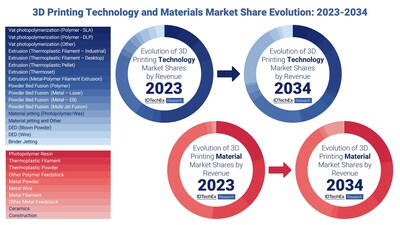Author: Sona Dadhania, Senior Technology Analyst at IDTechEx
BOSTON, Feb. 7, 2024 /PRNewswire/ — Ten years ago, the 3D printing landscape was in the midst of its first big boom. With the 2009 expiration of a key Stratasys patent that covered thermoplastic filament extrusion technology, desktop filament printers were taking off, buoyed by new disrupters like Makerbot. The general public was being introduced to the possibilities of 3D printing through countless eye-popping headlines that speculated on 3D printing’s application in everything from toys to phones to organs.
Ten years later, the 3D printing landscape has clearly shifted dramatically. While desktop filament printers are still the dominant printer type by volume, the value of professional and industrial-level printers is taking up most of the focus. The company landscape in additive manufacturing has also transformed, with prior players merging or exiting and new players consistently emerging. This demonstrates the shifting nature of this technologically evolving industry, one that IDTechEx expects to evolve considerably over the next ten years as well. What will be some of the short- and long-term trends affecting this industry in the next decade? IDTechEx explores this question in their latest report, “3D Printing and Additive Manufacturing 2024-2034: Technology and Market Outlook“, and presents some of those trends below.
Additive manufacturing trends, as identified by IDTechEx
The growth of powder bed-based technologies: the goal of nearly every company in the 3D printing space has been to identify the mid- to high-volume applications that 3D printing could successfully serve. Steadily, it appears that more and more of these applications are being identified, whether they be sand casting cores for mass production electric vehicles or casings for smartphones. These types of applications often necessitate powder-bed 3D printing technologies, which are better equipped to deal with the throughput requirements of higher-volume applications. Hence, IDTechEx expects powder bed-based printing technologies, such as laser powder bed fusion or binder jetting, to grow considerably over the next decade. This will be reflected in the growing yet dominant market share of powder materials in the 3D printing materials market.

A less fragmented company landscape in additive manufacturing: with challenging macro-economic conditions creating a more conservative environment for raising capital and financial risk-taking, the importance of achieving profitability has never been so important for 3D printing companies of all sizes. With such a fragmented market consisting of over 1000 players in 3D printing hardware alone, it is necessary for mergers, acquisitions, and exits to take place at an increasing pace over the mid to long term, such that 3D printing companies may consolidate enough to actually facilitate reaching profitability.
A more interesting approach to sustainability: the conversation about sustainability in 3D printing is beginning to move beyond the simplest sustainability benefits that 3D printing offers – the reduction of material waste compared to subtractive manufacturing technologies. There will be additional consideration of the energy sources used to power energy-intensive printing technologies. Innovation will make recycled materials, including polymers, metals, and composites, much more suitable for both low- and high-performance applications. Increased incorporation of AI-driven software into 3D printing supply chains will help to reduce other waste-generating elements of additive manufacturing, such as supports and prints with defects.
Focus on developing higher performance materials for 3D printing: the inadequacies of current 3D printing materials are a well-known barrier to adoption for additive manufacturing; compared to the thousands of tried-and-tested injection molding plastic grades, the relatively limited materials portfolio of 3D printing has not yet gained the trust of many end-users. Not only is R&D effort being expended to reduce the deficiencies of 3D printing materials, but many companies are also looking to create novel high-performing materials to better suit the rigorous demands of many 3D printing application sectors. The many innovative materials being explored for additive manufacturing, from high entropy alloys to nanocarbon reinforced composites to non-oxide ceramics and more, will not only increase 3D printing’s materials portfolio but also expand 3D printing’s compatibility for various applications in the long-term.
IDTechEx 3D printing market forecasts
IDTechEx’s report, “3D Printing and Additive Manufacturing 2024-2034: Technology and Market Outlook”, carefully segments the market by eighty different forecast lines across seventeen different technology categories, four major material categories, and eight material subcategories. These hardware and material forecasts analyze future installations, hardware unit sales, hardware revenue, materials mass demand, and material revenue. Additionally, IDTechEx provides comprehensive technology benchmarking studies, examination and case studies of critical application areas, a detailed discussion of auxiliary AM industry fields, and in-depth market and economic analysis. For further information on this market, including 150 interview-based profiles of market leaders and start-ups, technology comparison studies, business model analysis, and granular 10-year market forecasts, please visit www.IDTechEx.com/3dp. Downloadable sample pages are available for this report.
For the full portfolio of 3D Printing research available from IDTechEx, please visit www.IDTechEx.com/Research/3D.
About IDTechEx
IDTechEx guides your strategic business decisions through its Research, Subscription and Consultancy products, helping you profit from emerging technologies. For more information, contact [email protected] or visit www.IDTechEx.com.
Images download: https://www.dropbox.com/scl/fo/vti77cc9t0d55b8nya8s7/h?rlkey=ij95qb6orjc3v9uw85lzxfvcc&dl=0
Media Contact:
Lucy Rogers
Sales and Marketing Administrator
[email protected]
+44(0)1223 812300
Social Media Links:
Twitter: www.twitter.com/IDTechEx
LinkedIn: www.linkedin.com/company/IDTechEx
Infographic – https://mma.prnewswire.com/media/2334748/IDTechEx.jpg
Logo – https://mma.prnewswire.com/media/2334770/IDTechEx_Logo.jpg

![]() View original content:https://www.prnewswire.co.uk/news-releases/idtechex-discusses-the-long-term-trends-shaping-additive-manufacturing-302054825.html
View original content:https://www.prnewswire.co.uk/news-releases/idtechex-discusses-the-long-term-trends-shaping-additive-manufacturing-302054825.html

Featured image: DepositPhotos © jonysek





